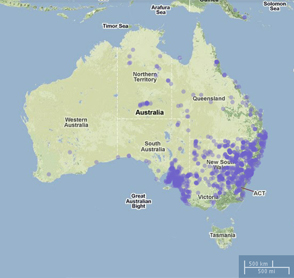Specimen and observation data

The ALA aims to help researchers to understand the distribution of Australian plants and animals. To make this possible, the Atlas is building a system to catalogue electronic data records derived from specimens held in natural history collections and from field observations and ecological data sets. This will give users an integrated site to search for data on the occurrence of any Australian species and to list which species are known to have been recorded in any part of the country. When coupled with other data describing environmental factors, these data can also be used to analyse the environmental requirements for each species and to address questions of conservation and land use.
We are therefore interested in learning of any suitable data sets which could be shared through the ALA. As a minimum such data sets should include the scientific name for the species and the geographic coordinates, locality and date where the organism was observed or collected, but we will assist data providers to share as much information as they are able.
Some such data sets are already accessible online using the tools and standards described under Sharing data with the ALA and we plan to start by linking these resources. We would however like to learn of all relevant data sets so we can plan how to assist data providers with getting their data online.
If you are responsible for a data set containing specimen or observation data for Australian species, and are interested in sharing these data through the ALA, please send an email to data_management@ala.org.au including the following information:
- Your contact details
- The source of the data (collection database, field work, personal observations, etc.)
- The species or taxonomic groups included
- The geographic area covered
- The approximate number of records included
- How the data are currently stored (searchable web database, local database, spreadsheet, etc.)
- Whether you have access to a web server through which you could share the data
We will use this information to help us to understand what tools and services we need to offer to make it easy for data owners to share their information.
Thank you in advance for your involvement.